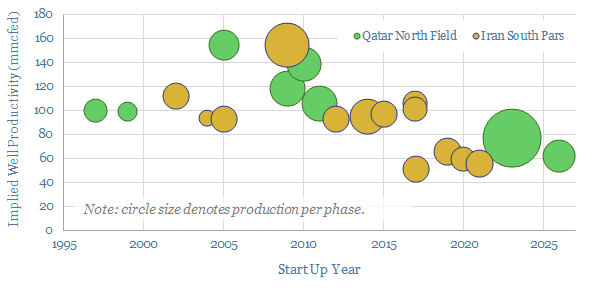North Field gas production is now the most important conventional energy source on the planet. It produces 4% of world energy, 20% of global LNG and aims to ramp another 50MTpa of low-carbon LNG by 2028. But what if Qatar’s exceptional reliability gets disrupted by unforeseen conflict with Iran? Without wishing to catastrophize, this 18-page note on the North Field energy production explores important tail-risks for near-term energy balances and long-term energy transition.
There is no slack in the system for LNG outages in 2022-26. Our global energy balances, gas balances, and the ‘hole’ left by possible Russian gas supply disruptions are quantified on pages 2-4.
Thus the Qatari North Field is now the most important conventional gas field in the world. It underpins 20% of global LNG. And as it straddles the Iranian border, the combined output from the field equates to 4% of all useful energy on the planet (equivalent to all of the world’s wind and solar assets combined) (pages 5-6).
And it is being expanded, adding another 50MTpa of low-carbon LNG to quell LNG under-supply in the mid-late 2020s, which helps advance energy security and global decarbonization (pages 7-9).
But what if this enormous field were to disappoint in some way? Its historical reliability has been exceptional. However, without wishing to catastrophize, there is now evidence of intensifying resource competition between Qatar and Iran causing well productivities to decline at the field. We have aggregated data from technical papers and press reports on pages 10-13.
Or worse. Iran is literally designated as the world’s leading State sponsor of terrorism by the US government. It has a fraught historical relationship with the West, with the GCC and with Qatar. It has funded drone attacks on Saudi oil infrastructure. Vladimir Putin visited Iran in July-2022, to discuss greater cooperation. Again, without wishing to catastrophize, this warrants some objective analysis over tail risks (pages 14-17).
Our conclusions, for energy markets and energy transition, are laid out on pages 17-18. A resilient energy system will need to be well diversified, including a buffer of excess capacity, if the world seeks to decarbonize without excessive risks.
Underlying data on North Field gas production and productivity is linked here.

